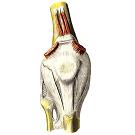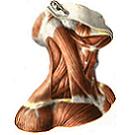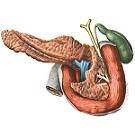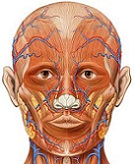Pulmonary trunk
The pulmonary trunk , truncus pulmonalis, has a length of 5-6 cm and a width of up to 3 cm; It is a continuation of the arterial cone of the right ventricle and begins from the opening of the pulmonary trunk. Its initial part, going from below and right up and to the left, is located in front and to the left of the ascending aorta. Initially, the artery is somewhat enlarged and forms a sinus of the pulmonary trunk, sinus trunci pulmonalis, in which three small lobes are distinguished by the number of semilunar valves of the pulmonary valve.

Further, the pulmonary trunk passes to the left of the ascending part of the aorta, passes in front of the left atrium and under the arch of the aorta. Here, at the level of the body IV of the thoracic vertebra or the upper edge of the cartilage of the left II rib, it is divided into two branches: the right pulmonary artery, a. Pulmonalis dextra, and the left pulmonary artery, a. Pulmonalis sinistra; Each of them goes to the gate of the corresponding lung, bringing to him venous blood from the right ventricle.

The place of division of the pulmonary trunk into these two branches is called bifurcation of the pulmonary trunk, bifurcatio trunci pulmonalis.
Right pulmonary artery, a. Pulmonalis dextra, somewhat longer and wider than the left. It goes transversely from left to right, being located behind the ascending part of the aorta and the superior vena cava, anterior to the right main bronchus. Entering the root of the lung, the artery divides into the ascending (upper) and descending (inferior) branches, giving off the lobar branches; The latter in turn give off segmental branches. The ascending branch is distributed in segments of the upper lobe, and the descending branch will give the branches to the segments of the middle and lower lobes. The lower branch, passing to the basal part, pars basalis, sends the branches to the segments of the base of the lower lobe.
Branch of the upper lobe, rr. Lobi superioris:
1. The apical branch, r. Apicalis, departs from the upper branch and, accompanying the bronchus of the same name, goes upward and enters the apical segment. In relation to the bronchus occupies a medial position.
2. Anterior descending branch, r. Anterior descendens, departs from the upper branch of the right pulmonary artery, often one trunk with the apical branch, and, moving forward and down, enters the anterior segment. It is located somewhat higher than the segmental bronchus.
3. Front ascending branch, r. Anterior ascendens, unstable, often departs from the descending trunk and, moving forward and upward, approaches the anterior segment from its lower surface.
4. Rear descending branch, r. Posterior descendens, may retire independently or with one trunk with apical branch, and, going back and forth, passes in an oblique slot, plunging into the posterior segment.
5. Rear ascending branch, r. Posterior ascendens, departs from the posterolateral surface of the descending trunk of the right pulmonary artery. It passes in the interlobar fissure and, dividing into two branches - ventral and dorsal, accompanying the segmental bronchus, enters the posterior segment.
Branches of middle lobe, rr. Lobi medii. These branches extend from the lower branch of the right pulmonary artery, located lateral to the right mid-lobe bronchus, respectively, to the two segments constituting the average proportion. Sometimes these branches can depart independently.
1. The literal branch, r. Lateralis, together with the bronchus enters the lateral segment and is divided into the posterior and anterior branches.
2. The medial branch, r. Medialis, enters the eponymous segment with the bronchus and divides into the upper and lower branches.
The branches of the lower lobe, rr. Lobi inferioris:
1. The upper branch of the lower lobe, r. Superior lobi inferioris, departs independently from the posterior surface of the lower truths by the right pulmonary artery, between the branch of the middle lobe and beginning just below the basal part. Approaching the apical segment of the lower lobe r. Apicalis like the bronchus of the same name, gives the medial, upper and lateral branches.
2. The basal part, pars basalis, is the terminal section of the lower trunk of the right pulmonary artery and gives branches to the four segments of the base of the lower lobe. Sometimes the branches of the basal part unite into two trunks, which in turn give up two segmental arteries; Less often, each branch is approached by an independent branch.
1) Medial basal branch, r. Basalis medialis, the thinnest of all arterial branches. Going down and down, along with the bronchus, approaches the medial segment, occupying a medial position with respect to the bronchus.
2) Anterior basal branch, r. Basalis anterior, directed outward and downward, penetrating together with the bronchus into the segment from the side of its upper medial surface.
3) Lateral basal branch, r. Basalis lateralis, often departs common trunk with anterior basal branch. It is directed down and out and together with the bronchus, lying behind it, enters the lateral segment.
4) The posterior basal branch, r. Basalis posterior, more powerful than the previous one, is directed downwards and backwards. Together with the bronchus approaches the anterior surface of the posterior segment, it enters into it, dividing into the lateral and medial branches.
Left pulmonary artery, a. Pulmonalis sinistra, runs transversely from right to left in front of the thoracic part of the aorta and the main left bronchus. In the root of the lung, it forms an arc directed posteriorly, and then divides into branches of the upper lobe and lower lobe branches that enter the gates of the corresponding lobes of the left lung. Sometimes sharp division into lobar branches is not observed, and then the segmental branches divide into the root of the lung into three groups: beginning in front, behind and above the root of the lung.
Branch of the upper lobe, rr. Lobi superioris:
1. The apical branch, r. Apicalis, departs from the initial section of the arc of the pulmonary artery and, going up, enters with the segmental bronchus into the apical-posterior segment from the side of its lower medial surface, giving up the upper and anterior branches.
2. Rear branch, r. Posterior, often departs from the left pulmonary artery and, going up and back, enters along with the bronchus into the apical-posterior segment from the side of its medial surface.
3. Front ascending branch, r. Anterior ascendens, unstable. It can move away from the left pulmonary artery independently, but often leaves together with the back branch. Going upwards, enters the apical-posterior segment, being an additional branch.
4. Anterior descending branch, r. Anterior descendens, lies anterior to the lobar bronchus. It departs next to the apical branch from the anterior surface of the left pulmonary artery and, moving forward and somewhat upward, enters the anterior segment.
5. The tongue branch, r. Lingularis, move away from the anterior surface of the descending section of the left pulmonary artery, above the place of its transition to the basal part. The bowl branches out in front of the main left bronchus on the bottom of the branch: the upper tongue branch, r. Lingularis superior, and lower ligament branch, r. Lingularis inferior, which together with the same bronchi enter respectively into the upper and lower reed segments. Sometimes these branches move away from the pulmonary artery separately then the reed branch as a common trunk is absent.
The branches of the lower lobe, rr. Lobi inferioris:
1. The upper branch of the lower lobe, r. Superior lobi inferioris, departs from the posterior surface of the pulmonary artery slightly above the ligulate branch. It is a very powerful branch, it goes to the back and to the outside, and you have a bronchus entering the apical segment of the lower lobe, separating intra-segmentally into the medial, upper and lateral branches.
2. The basal part, pars basalis, of the left pulmonary artery constitutes the continuation of the artery after the upper branch of the lower lobe. From it, the arterial branches branch to the four basal segments of the lower lobe of the left lung, with differences in the departure and topography of these branches.
1) Medial basal branch, r. Basalis medialis, often departs common trunk with anterior basal branch. Going down, the branch, repeating the course of the bronchus, approaches the upper medial surface of the medial (cardiac) basal segment. In some cases, from this branch to the site of its immersion into the segment, the artery travels to the lateral basal segment. Intrasegmentually gives two branches - lateral and medial.
2) Anterior basal branch, r. Basalis anterior, departs from the basal part more often with a common trunk together with the medial basal branch. It is directed forward and down, entering along with the bronchus into the anterior basal segment from the side of its medial surface. Intrasegmentarily divided into anterior and basal branches.
3) Lateral basal branch, r. Basalis lateralis, departs from basal cleansing more often independently, less often it can depart with the medial or anterior basal branch. The course of the branch does not always correspond to the segmental bronchus of the same name. If the latter enters the segment from the side of its upper edge, then the artery, going downwards and anteriorly, is immersed in the segment from the medial surface.
4) The posterior basal branch, r. Basalis posterior, can depart from the basal part independently, less often along with the lateral basal branch. It is directed down and outward and enters the segment along with the bronchus from the side of its medial surface.

From the pulmonary trunk in the area of its bifurcation to the front surface of the concavity of the arch of the aorta is directed the fibrous-muscular stitch - arterial ligament, lig. Arteriosum. Its length is up to 1 cm, and the thickness is up to 3 mm. The arterial ligament departs from the left pulmonary artery, less often from the pulmonary trunk, closer to the origin of the left artery, and terminates on the aorta, somewhat lateral to the left subclavian artery.
In the prenatal period, this ligament is an arterial duct, ductus arteriosus, through which most of the blood from the pulmonary trunk passes into the aorta. After birth, the duct is obliterated, turning into the indicated ligament.









Comments
When commenting on, remember that the content and tone of your message can hurt the feelings of real people, show respect and tolerance to your interlocutors even if you do not share their opinion, your behavior in the conditions of freedom of expression and anonymity provided by the Internet, changes Not only virtual, but also the real world. All comments are hidden from the index, spam is controlled.